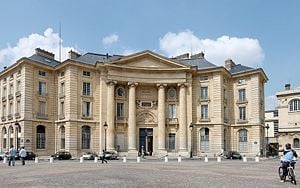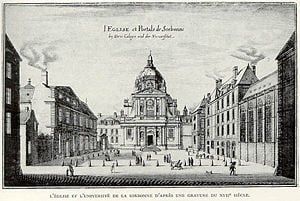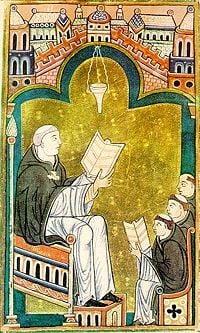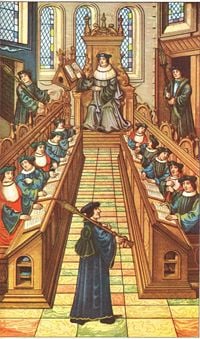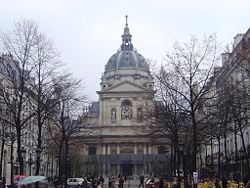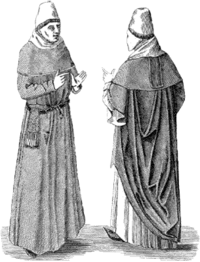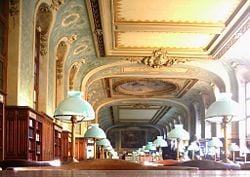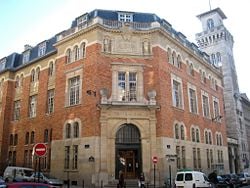The historic University of Paris (French: Universit√© de Paris) first appeared in the second half of the twelfth century, but was in 1970 reorganized as 13 autonomous universities (University of Paris I‚ÄďXIII). The university is often referred to as the Sorbonne or La Sorbonne after the collegiate institution (Coll√®ge de Sorbonne) founded in 1257 by Robert de Sorbon, but the university as such was older and was never completely centered on the Sorbonne. Of the thirteen current successor universities, four have a presence in the historical Sorbonne building, and three include "Sorbonne" in their names.
The original university had four faculties: Arts, Medicine, Law, and Theology. The students there were divided into four nationes according to language or regional origin. This faculty and nation system of the University of Paris (along with that of the University of Bologna) became the model for all later medieval universities in Europe. Remarkable for its teaching, the University of Paris also played an important role in both religious and political affairs in France. However, with the French Revolution the ancient University of Paris was swept away along with the Ancien Régime, becoming part of the University of France. Reestablished in 1886, without its faculty of theology and with the addition of new faculties such as science, the university became secular. Still it again became a preeminent academic center, not just of France but of Europe as a whole in the mid-twentieth century.
After the protests of 1968, which the University was significantly involved in, however, the French higher education system was again reformed, and the University of Paris was separated into 13 universities. Thus, despite their historical ties and some administrative functions of the Académie of Paris with offices in the Sorbonne, there is currently no University of Paris system that binds the universities at an academic level. Yet, the ideal of the University of Paris, the archetype of so many significant universities and the center of such historical intellectual development, continues to inspire and inform many. For although reform, such as that invoked by the French Revolution, has often been necessary in history to remove corrupt and outdated institutions, the wisdom and spirit of their founders is often of eternal value to humankind.
History
Similar to the other early medieval universities (University of Bologna, University of Oxford), but unlike later ones (such as the University of Prague or the University of Heidelberg), the University of Paris was only later established through a specific foundation act (such as a royal charter or papal bull). The university grew up in the latter part of the twelfth century around the Notre Dame Cathedral as a corporation similar to other medieval corporations, such as guilds of merchants or artisans. In fact, the medieval Latin term universitas actually had the more general meaning of a guild, and the university of Paris was known as a universitas magistrorum et scholarium (a guild of masters and scholars).
The university had four faculties: Arts, Medicine, Law, and Theology. The faculty of Arts was the lowest in rank, but also the largest as students had to graduate from there to be admitted to one of the higher faculties. The students there were divided into four nationes according to language or regional origin, those of France, Normandy, Picard, and England, the last one of which later came to be known as the Alemannian (German) nation. Recruitment to each nation was wider than the names might imply: the English-German nation in fact included students from Scandinavia and Eastern Europe. The faculty and nation system of the University of Paris (along with that of the University of Bologna) became the model for all later medieval universities.
The original schools
Three schools were especially famous at Paris, the palatine or palace school, the school of Notre-Dame, and that of Sainte-Geneviève. The decline of royalty inevitably brought about the decline of the first. The other two, which were very old, like those of the cathedrals and the abbeys, were only faintly outlined during the early centuries of their existence. The glory of the palatine school doubtless eclipsed theirs, until in the course of time it completely gave way to them.
The first renowned professor at the school of Ste-Genevi√®ve was Hubold, who lived in the tenth century. Not content with the courses at Li√®ge, he continued his studies at Paris, entered or allied himself with the chapter of Ste-Genevi√®ve, and attracted many pupils via his teaching. Distinguished professors from the school of Notre-Dame in the eleventh century include Lambert, disciple of Filbert of Chartres; Drogo of Paris; Manegold of Germany; Anselm of Laon. These two schools attracted scholars from every country and produced many illustrious men, among whom were: Saint Stanislaus of Szczepan√≥w, Bishop of Krak√≥w; Gebbard, Archbishop of Salzburg; St. Stephen, third Abbot of C√ģteaux; and Robert d'Arbrissel, founder of the Abbey of Fontevrault. Three other men who added esteem to the schools of Notre-Dame and Ste-Genevi√®ve were William of Champeaux, Peter Abelard, and Peter Lombard.
The school of St-Victor then arose to rival those of Notre-Dame and Ste-Geneviève. It was founded by William of Champeaux when he withdrew to the Abbey of St-Victor. Its most famous professors are Hugh of St-Victor and Richard of St-Victor.
Originally instruction comprised grammar, rhetoric, dialectics, arithmetic, geometry, music, and astronomy (trivium and quadrivium). To the higher instruction belonged dogmatic and moral theology, whose source was the Scriptures and the Fathers, and which was completed by the study of Canon law. The plan of studies expanded in the schools of Paris, as it did elsewhere. A Bolognese compendium of canon law called the "Decretum Gratiani" brought about a division of the theology department. Hitherto the discipline of the Church had not been separate from so-called theology; they were studied together under the same professor. But this vast collection necessitated a special course, which was naturally undertaken first at Bologna, where Roman law was taught. In France, first Orléans and then Paris erected chairs of canon law. Before the end of the twelfth century, the Decretals of Gerard (or Girard) La Pucelle, Mathieu d'Angers, and Anselm (or Anselle) of Paris, were added to the Decretum Gratiani. However, civil law was not included at Paris.
In the course of the twelfth century, medicine also began to be publicly taught at Paris: the first professor of medicine in Paris records is Hugo, physicus excellens qui quadrivium docuit.
Two things were necessary to be a professor: knowledge and appointment. Knowledge was proved by examination, the appointment came from the examiner himself, who was the head of the school, and was known as scholasticus, capiscol, and eventually as "chancellor." This appointment was called the license to teach. The license had to be granted freely. No one could teach without it; on the other hand, it could not be refused when the applicant deserved it.
The School of St-Victor, which shared the obligations as well as the immunities of the abbey, conferred the license in its own right; the school of Notre-Dame depended on the diocese, that of Ste-Geneviève on the abbey or chapter. The diocese and the abbey or chapter, through their chancellor, gave professorial investiture in their respective territories where they had jurisdiction.
Besides Notre-Dame, Ste-Geneviève, and St-Victor, there were several schools on the "Island" and on the "Mount." "Whoever," says Crevier "had the right to teach might open a school where he pleased, provided it was not in the vicinity of a principal school." Thus a certain Adam, who was of English origin, kept his "near the Petit Pont"; another Adam, Parisian by birth, "taught at the Grand Pont which is called the Pont-au-Change" (Tuilier, 1997 vol. I, 272).
The number of students in the school of the capital grew constantly, so that eventually the lodgings were insufficient. French students included princes of the blood, sons of the nobility, and the most distinguished youths of the kingdom. The courses at Paris were considered so necessary as a completion of studies that many foreigners flocked to them. Popes Celestine II, Adrian IV, and Innocent III studied at Paris, and Alexander III sent his nephews there. Illustrious German and British students included Otto of Freisingen, Cardinal Conrad, Archbishop of Mainz, St. Thomas of Canterbury, and John of Salisbury; while Ste-Geneviève became practically the seminary for Denmark. The chroniclers of the time call Paris the city of letters par excellence, placing it above Athens, Alexandria, Rome, and other cities. Poets said the same thing in their verses, and they compared it to all that was greatest, noblest, and most valuable in the world.
The three schools of Notre-Dame, Ste-Geneviève, and St-Victor may be regarded as the triple cradle of the Universitas scholarium, which included masters and students; hence the name University.
Organization in the thirteenth century
In 1200, King Philip II issued a diploma "for the security of the scholars of Paris" that made the students subject only to ecclesiastical jurisdiction. The provost and other officers were forbidden to arrest a student for any offense, unless this was done to hand over the culprit to ecclesiastical authority. The king's officers could never lay hands on the head of the schools unless they had a mandate from an ecclesiastical authority.
In 1215, the statues of the Apostolic legate, Robert de Courçon, dealt with three principal points regarding the moral and intellectual part of university instruction: the conditions of the professorate, the matter to be treated, and the granting of the license. To teach the arts it was necessary to have reached the age of twenty-one, after having studied these arts at least six years, and to take an engagement as professor for at least two years. For a chair in theology the candidate had to be thirty years of age with eight years of theological studies, of which the last three years were devoted to special courses of lectures in preparation for the mastership. Lastly, purity of morals was as important as reading. Priscian's "Grammar," Aristotle's "Dialectics," mathematics, astronomy, music, certain books of rhetoric and philosophy were the subjects taught in the arts course; to these might be added the Ethics of the Stagyrite and the fourth book of the Topics. The license was granted, according to custom, gratuitously, without oath or condition, and instruction was also free. However, it was often necessary to depart from the rule. Thus the pope authorized Pierre Le Mangeur to levy a moderate fee for the conferring of the license. Similar fees were exacted for the first degree in arts and letters.
In 1229, a denial of justice by the queen led to suspension of the courses, known as the University of Paris strike of 1229. The pope intervened with a Bull that began with lavish praise of the university: "Paris," said Gregory IX, "mother of the sciences, is another Cariath-Sepher, city of letters." He compared it to a laboratory in which wisdom tested the metals which she found there, gold and silver to adorn the Spouse of Jesus Christ, iron to fashion the spiritual sword which should smite the inimical powers. He commissioned the Bishops of Le Mans and Senlis and the Archdeacon of Ch√Ęlons to negotiate with the French Court for the restoration of the university. The year 1230 came to an end without any result, and Gregory IX took the matter directly in hand by a Bull of 1231 addressed to the masters and scholars of Paris. Not content with settling the dispute and giving guarantees for the future, he empowered the university to frame statutes concerning the discipline of the schools, the method of instruction, the defense of theses, the costume of the professors, and the obsequies of masters and students (expanding upon Robert de Cour√ßon's statutes). Most importantly, the pope recognized in the university or granted it the right to suspend its courses, if justice were denied it, until it should receive full satisfaction.
Thus the University of Paris, which in general was the model for other universities, assumed its basic form. It was composed of seven groups, the four nations of the faculty of arts, and the three superior faculties of theology, law, and medicine. Church officials lavishly praised the university: St. Louis, in the diploma which he granted to the Carthusians for their establishment near Paris, speaks of this city, where "flow the most abundant waters of wholesome doctrine, so that they become a great river which after refreshing the city itself irrigates the Universal Church."
Colleges
The scattered condition of the scholars in Paris often made lodging difficult. Some students rented rooms from townspeople, who often exacted high rates. This tension between scholars and citizens would have developed into a sort of civil war if Robert de Courçon had not found the remedy of taxation. It was upheld in the Bull of Gregory IX of 1231, but with an important modification: its exercise was to be shared with the citizens. The aim was to offer the students a shelter where they would fear neither annoyance from the owners nor the dangers of the world. Thus were founded the colleges, which were not usually centers of instruction, but simple student boarding-houses. Each had a special object, being established for students of the same nationality or the same science. They also enabled students to use their time more wisely, sometimes under the guidance of resident masters.
Four colleges appeared in the twelfth century; they became more numerous in the thirteenth, including Collège d'Harcourt (1280) and the Collège de Sorbonne (1257).
Besides the famous Collège de Sorbonne, other collegia provided housing and meals to students, sometimes for those of the same geographical origin in a more restricted sense than that represented by the nations. There were eight or nine collegia for foreign students: the oldest one was the Danish college, the Collegium danicum or dacicum, founded in 1257. Swedish students could, during the thirteenth and fourteenth centuries, live in one of three Swedish colleges, the Collegium Upsaliense, the Collegium Scarense, or the Collegium Lincopense, named after the Swedish dioceses of Uppsala, Skara, and Linköping, the cathedral schools of which the scholars had presumably attended before travelling to Paris. The Scottish college or Collegium scoticum was founded in 1325 and the German College, Collegium alemanicum, is mentioned as early as 1345. The Lombard college or Collegium lombardicum was founded in the 1330s. The Collegium constantinopolitanum was, according to a tradition, founded in the thirteenth century to facilitate a merging of the eastern and western churches. It was later reorganized as a French institution, the Collège de la Marche-Winville. The Collège de Montaigu was founded by the Archbishop of Rouen in the fourteenth century, and reformed in the fifteenth century by the humanist Jan Standonck, when it attracted reformers from within the Roman Catholic Church (such as Erasmus and Loyola) and those who subsequently became Protestants (John Calvin and John Knox).
Hastings Rashdall, in The Universities of Europe in the Middle Ages (1895), which is still a standard reference on the topic, lists some 70 colleges of the university from the Middle Ages alone; some of these were short-lived and disappeared already before the end of the medieval period, but others were founded in the Early modern period, like the Collège des Quatre-Nations.
Fifteenth century
In the fifteenth century, Guillaume d'Estouteville, a cardinal and Apostolic legate, carried out a project to reform the university, correcting its abuses and introducing various needed modifications. This reform was less an innovation than a recall to the better observance of the old rules, as was the reform of 1600, undertaken by the royal government, with regard to the three superior faculties. For the faculty of arts, however, the reform of 1600 introduced the study of Greek, of the French poets and orators, and of additional classical figures like Hesiod, Plato, Demosthenes, Cicero, Virgil, and Sallust. The prohibition to teach civil law was never well observed at Paris, but in 1679 Louis XIV authorized the teaching of civil law in the faculty of decretals. Thus, the name "faculty of law" replaced that of "faculty of decretals." The colleges meantime had multiplied; those of Cardinal Le-Moine and Navarre were founded in the fourteenth century. The Hundred Years' War was fatal to these establishments, but the university set about remedying the injury.
Remarkable for its teaching, the University of Paris played an important role in many areas: in the Church, during the Great Schism; in the councils, in dealing with heresies and deplorable divisions; in the State, during national crises; and though under the domination of England it dishonored itself in the trial of Joan of Arc, it rehabilitated itself by rehabilitating Joan. Proud of its rights and privileges, it fought energetically to maintain them, hence the long struggle against the mendicant orders on academic as well as on religious grounds. Hence also the shorter conflict against the Jesuits, who claimed by word and action a share in its teaching. It made liberal use of its right to decide administratively according to occasion and necessity. In some instances it openly endorsed the censures of the faculty of theology and pronounced condemnation in its own name, as in the case of the Flagellants.
Its patriotism was especially manifested on two occasions. During the captivity of King John, when Paris was given over to factions, the university sought to restore peace; and under Louis XIV, when the Spaniards crossed the Somme and threatened the capital, it placed two hundred men at the king's disposal and offered the Master of Arts degree gratuitously to scholars who should present certificates of service in the army.
Establishment of the University of France
The ancient University of Paris was swept away along with the Ancien Régime during the French Revolution. On September 15, 1793, petitioned by the Department of Paris and several departmental groups, the National Convention decided that independently of the primary schools,
there should be established in the Republic three progressive degrees of instruction; the first for the knowledge indispensable to artisans and workmen of all kinds; the second for further knowledge necessary to those intending to embrace the other professions of society; and the third for those branches of instruction the study of which is not within the reach of all men.
Measures were to be taken immediately:
For means of execution the department and the municipality of Paris are authorized to consult with the Committee of Public Instruction of the National Convention, in order that these establishments shall be put in action by 1 November next, and consequently colleges now in operation and the faculties of theology, medicine, arts, and law are suppressed throughout the Republic.
This was a death-sentence for the university. All universities throughout the land were replaced by a single center, the University of France. After a century (in 1896), people recognized that the new system was less favorable to study and restored the old system, but without the faculty of theology.
Organization
The name Sorbonne (La Sorbonne) is commonly used to refer to the historic University of Paris or one of its successor institutions (see below), but this is a recent usage, and "Sorbonne" has actually been used with different meanings over the centuries.
The name is derived from the Collège de Sorbonne, founded in 1257 by Robert de Sorbon as one of the first significant colleges of the medieval University of Paris; the university as such predates the college by about a century, and minor colleges had been founded already in the late twelfth century. The Collège de Sorbonne was suppressed during the French revolution, reopened by Napoleon in 1808, and finally closed in 1882. This was only one of the many colleges of the University of Paris that existed until the French revolution.
During the later part of the nineteenth century, the buildings of the Collège de Sorbonne were re-used for the Faculties of Sciences and Letters of what was at the time known as the Academy of Paris, the name used for the faculties of the former University of Paris within the centralized structure known as the University of France, created in 1808 but dissolved into its constituent universities again in 1896. As a result of this, "Sorbonne" became a colloquial term for the entire University of Paris.
By the mid-twentieth century the University of Paris had one again become a preeminent academic center, with numerous distinguished professors. In May 1968, a protest by students at the University of Paris, beginning with conflicts between students and authorities in Nanterre and then an organized protest at the Sorbonne, led to the closing of the university and a serious national crisis. This led to major educational reform and the decentralization of schools.
In 1970, the historic university was divided into thirteen different universities. The thirteen universities stand under a common rectorate with offices in the Sorbonne. Four of these universities currently include the name "Sorbonne" in their names or are affiliated with the Sorbonne:
- Panthéon-Sorbonne University (Paris I), which also houses the observatory of the Sorbonne;
- Sorbonne Nouvelle University (Paris III);
- Paris-Sorbonne University (Paris IV);
- Paris Descartes University: Faculté des Sciences Humaines et Sociales - Sorbonne (Paris V).
These four public universities maintain facilities in the historical building of the Sorbonne. The building also houses the Rectorate of Paris (which manage all of the 13 unversities of Paris), the √Čcole Nationale des Chartes, the √Čcole pratique des hautes √©tudes, the Cours de Civilisation Fran√ßaise de la Sorbonne and the Library of the Sorbonne.
Today the word Sorbonne no longer refers to the University of Paris but to the historical building located in the Latin Quarter in the 5th arrondissement of Paris.
The 13 successor universities to the University of Paris are now split over the three academies of the Île-de-France region.
Thirteen successor universities
| I | Pantheon-Sorbonne University | Website | Academy of Paris | Paris Centre Universités |
| II | Pantheon-Assas University | Website | Academy of Paris | Paris Universitas |
| III | University of the New Sorbonne | Website | Academy of Paris | Paris Universitas |
| IV | Paris-Sorbonne University | Website | Academy of Paris | |
| V | René Descartes University | Website | Academy of Paris | Paris Centre Universités |
| VI | Pierre and Marie Curie University | Website | Academy of Paris | Paris Universitas |
| VII | Denis Diderot University | Website | Academy of Paris | Paris Centre Universités |
| VIII | University of Vincennes in Saint-Denis | Website | Academy of Créteil | Université de Paris Île-de-France |
| IX | Paris Dauphine University | Website | Academy of Paris | Paris Universitas |
| X | University of Nanterre | Website | Academy of Versailles | |
| XI | University of Paris-Sud | Website | Academy of Versailles | UniverSud Paris |
| XII | University of Val-de-Marne | Website | Academy of Créteil | Université Paris-Est |
| XIII | University of Paris-Nord | Website | Academy of Créteil | Université de Paris Île-de-France |
Six alliances of universities
Most of these universities have joined new groupings along the lines of a collegiate university. Typically, these groupings take the legal form of a Center for Research and Higher Education (P√īle de Recherche et d'Enseignement Sup√©rieur, or PRES), though some have opted for other forms of organization.
There are six such centers in the Paris region:
- Paris Centre Universités
- Paris Universitas
- Université Paris-Est
- UniverSud Paris
- Cergy-Pontoise Val-d'Oise
- Université de Paris Île-de-France
In the Paris region, these 13 universities are joined by four other public universities that historically were not part of the University of Paris system. One of these is in the Academy of Paris: the University of Marne la Vallée (also part of Université Paris-Est). The three others are in the Academy of Versailles: the University of Cergy-Pontoise (part of the PRES Cergy-Pontoise Val-d'Oise), the University of Versailles, Saint Quentin en Yvelines (also part of UniverSud Paris), and the University of Evry - Val d'Essonne.
While the universities are now essentially independent of each other, and some fall under the Académie of Paris while others fall under the Académie of Versailles, some residual administrative functions of the 13 universities are formally supervised by a common chancellor, the Rector of the Académie of Paris, with offices in the Sorbonne. Despite this link, and the historical ties, there is currently no University of Paris system that binds the universities at an academic level.
ReferencesISBN links support NWE through referral fees
- Ferruolo, Stephen. 1985. The Origins of University: The Schools of Paris and Their Critics, 1100-1215. Stanford University Press. ISBN 978-0804712668
- Leutrat, Jean-Louis. 1997. De l'Université aux Universités (From the University to the Universities). Paris: Association des Universités de Paris.
- Rashdall, Hastings. [1895] 1987. The Universities of Europe in the Middle Ages. Oxford University Press. ISBN 978-0198229834
- de Ridder-Symoens, Hilde. 2003. A History of the University in Europe: Volume 1, Universities in the Middle Ages (A History of the University in Europe). Cambridge University Press. ISBN 978-0521541138
- Rive, Philippe. 1987. La Sorbonne et sa reconstruction (The Sorbonne and its Reconstruction). Lyon: La Manufacture.
- Tuilier, André. 1997. Histoire de l'Université de Paris et de la Sorbonne (History of the University of Paris and of the Sorbonne). in 2 volumes (From the Origins to Richelieu, From Louis XIV to the Crisis of 1968), Paris: Nouvelle Librairie de France.
- Verger, Jacques. 1986. Histoire des Universités en France (History of French Universities). Toulouse: Editions Privat.
Credits
New World Encyclopedia writers and editors rewrote and completed the Wikipedia article in accordance with New World Encyclopedia standards. This article abides by terms of the Creative Commons CC-by-sa 3.0 License (CC-by-sa), which may be used and disseminated with proper attribution. Credit is due under the terms of this license that can reference both the New World Encyclopedia contributors and the selfless volunteer contributors of the Wikimedia Foundation. To cite this article click here for a list of acceptable citing formats.The history of earlier contributions by wikipedians is accessible to researchers here:
The history of this article since it was imported to New World Encyclopedia:
Note: Some restrictions may apply to use of individual images which are separately licensed.
